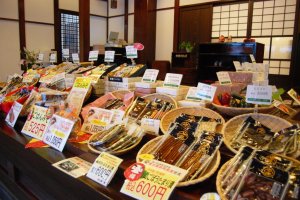Do you love eating Japanese pickles? Do you want to know how they are made? Then make your way to Honcho pickles factory in Tsuruoka City.
Housed in an old traditional building with some pine trees growing in the garden, this is a picture-book setting for a pickles factory. The Honcho business has been running for over 100 years. It was set up by the grandfather of the current Mr. Honcho.
Above the entrance of the factory hangs a signboard that was presented to the Honcho family by the 17th Sakai, a descendant of the local daimyo family. The Honcho family is very proud to have received this honor.
In grandfather Honcho’s days, they would preserve vegetables in sake only. Now they only pickle 40% of their output in this way. The remaining 60% of pickles are made by preserving the veggies in karashi (mustard sauce), in miso (soybean paste), tamari (a kind of soy sauce) or mirin (a kind of rice wine used for cooking).
Vegetables typically used for making pickles at the Honcho factory are various types of turnip, egg plant and cucumber. However, they also pickle uri (white cucumber), ume (Japanese plum), fuki-no-to (butterbur), myoga (a kind of ginger) or bamboo, negi (Welsh onion), ragyo (Japanese shallot) and shizo (a type of mint plant) as well as sansai (edible wild plants), to name just a few.
All vegetables are freshly sourced from farmers with whom the Honcho cooperate.
Adjunct to the factory is a small shop where the Honcho pickle products are on display and are sold. However, this is not the only place where Honcho pickles are on offer. Mr. Honcho explains that only one third of all output is sold locally. Another one third is sold in Takashimaya Department Stores in Tokyo and Osaka, and elsewhere in the country, and the remaining is sold online via their website.
You know that this pickle factory has tradition and is well established when you hear that the Honcho pickles have been exported since Japan’s Taisho Era (1912-1926). The majority of exported products end up on the plates of Japanese people living in other Asian countries or in the US.
Asking for the favorite product, Mr. Honcho explains that “Capponi Time”, pickles preserved in sake, is the absolute favorite of Honcho's customers.
You can tour the factory for free on weekdays from 8:30am to 16:30pm. Wearing some protective gear, you can watch the factory workers preparing the pickles or packaging them, all by hand. This is a small factory and there is no mass production going on here.
However, if you prefer a preview, then check out their comprehensive website. You can order some pickles online here and there is even a recipe section on the website.
Looking at the pictures on the Honcho website makes you want to eat some of these delicious pickles straightaway. I have tasted some during my visit at the factory and I got hooked. Since online ordering is easy and delivery in Japan is fast and efficient, I order some for my family’s consumption and to give as a present to friends.
Anyone who loves Japanese pickles will love the Honcho pickles, guaranteed.
Trip tip: Combine your visit at Honcho pickles factory in Oyama with a visit to nearby Watarai Honten sake brewery located in the same village.































